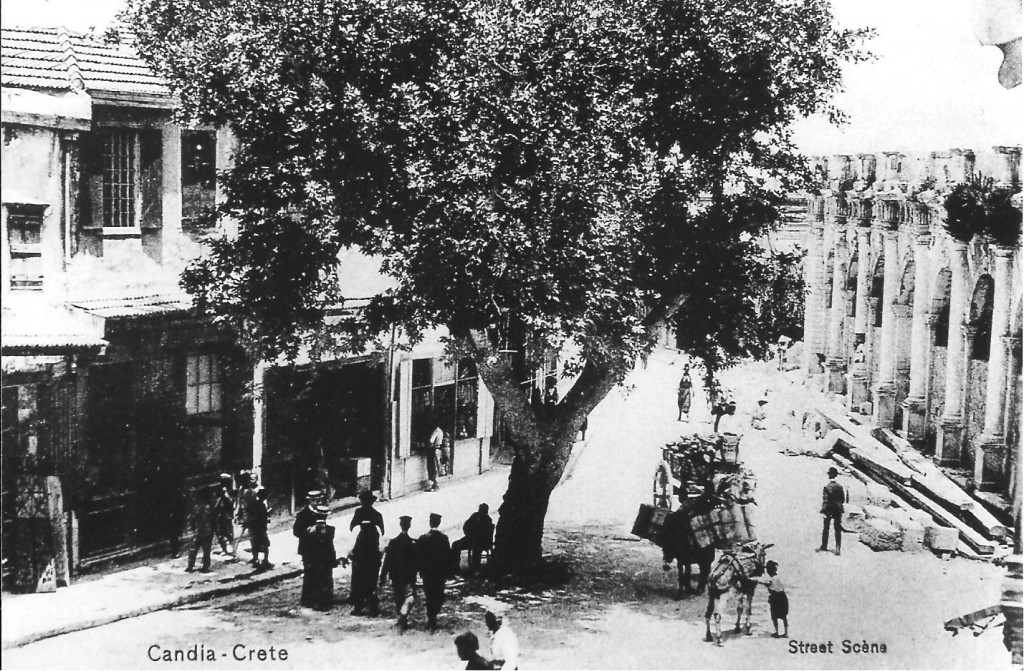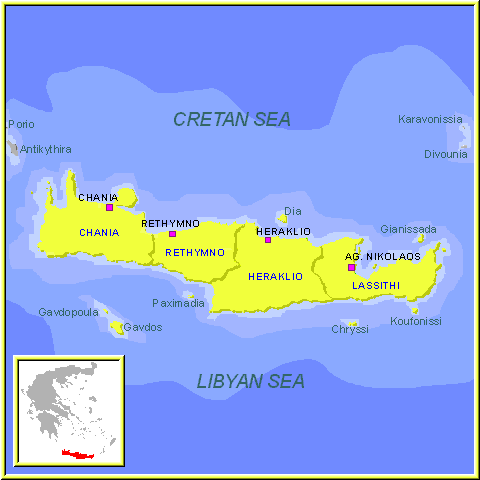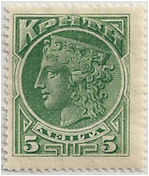ALBUM – view my Crete Album
TRANSITION CHART – Crete
Fast Facts
Region: Aegean Sea
Group: Crete
Classification: Military Occupation
Prior Regime: The Ottoman Empire
Key Dates:
1896 – Rebellion on Crete against the Ottomans
1897 – Greek troops land on Crete
1897 – Multimational forces land on Crete
1898, Nov – Ottoman forces withdraw from Crete and multinational forces assume control
1905, Apr – Theriso Revolution, martial law declared
1909 – Multinational Forces withdraw from Crete
1913 – Unification with Greece recognized after the Balkan wars
Following Regime: Kingdom of Greece
Scott Catalogue: (Crete) #50-120, J1-J26, O1-O6
Pick Catalogue: (Crete) #s154-s154
History

In 1897, a new Cretan insurrection led to the Ottoman Empire declaring war on Greece. As Greek troops landed on Crete, the Great Powers (Britain, France, Italy and Russia) decided that the Ottomans could no longer maintain control on Crete and imposed a blockade, and following Ottoman approval, established control on the island. Eventually an agreement was reached that Crete would be given autonomous status within the Ottoman Empire, but would be administered by Prince George of Greece, the second son of King George I, as High Commissioner. The Great Powers would continue to retain forces on the island to maintain order.
The occupying forces divided Crete into four zones, the British controlled Heraklion (Ηράκλειο), the Russians controlled Rethymnon (Ρέθυμνο), the Italians controlled Chania (Χανιά), and the French controlled Lasithi (Λασίθι). The capital of the autonomous government was located in Chania, and Prince George soon organized his leadership. Disagreements soon emerged between the Prince George and his minister of Justice, Eleftherios Venizelos, and ultimately he left the position in Mar, 1901.
For the next 3 years, Venizelos organized a strong political opposition, which eventually resulted in the Thériso Revolution. On 10 Mar 1905, rebels gathered in Thériso and declared “the political union of Crete with Greece as a single free constitutional state”. The resolution was presented to the Great Powers, but Prince George issued an ultimatum to cease their revolution, or he would be forced to take military action. The opposition at Theriso begin to grow, and on 18 Jul, 1905 the Great Powers declared martial law, but it didn’t deter the rebels. Eventually, on 15 Aug, the regular assembly in Chania voted in favor of most of the reforms that Venizelos proposed. In a subsequent meeting with Venizelos, The Great Powers’ consuls accepted the reforms which ended the revolt and resulted in the resignation of Prince George as High Commissioner.
The changes essentially nullified Ottoman suzerainty and Greek officers and non-commissioned officers were allowed to undertake the organization of Cretan protection. By 1909 the last of the Great Powers forces left the island, and in 1913, after the Balkan Wars, the annexation by Greece was fully recognized. Eleftherios Venizelos, went on be one of the most influential people in modern Greek history, serving as Prime Minister for multiple terms, and bringing Greek Society and Culture into modern times.

Stamps
 There are essentially three “periods” of stamps issuing by the autonomous Crete government: the establishment period, the revolutionary period and the annexation period. The first postage stamps for the autonomous government were issued in March of 1900. The stamps, issued in Greek currency, featured various themes of Greek mythology, as well as a design which depicting the image of Prince George. These stamps which were similar in design to stamps of Greece issued of the period, and many of them were overprinted in black or red “ΠΡΟΣΩΡΙΝΟΝ” meaning provisional.
There are essentially three “periods” of stamps issuing by the autonomous Crete government: the establishment period, the revolutionary period and the annexation period. The first postage stamps for the autonomous government were issued in March of 1900. The stamps, issued in Greek currency, featured various themes of Greek mythology, as well as a design which depicting the image of Prince George. These stamps which were similar in design to stamps of Greece issued of the period, and many of them were overprinted in black or red “ΠΡΟΣΩΡΙΝΟΝ” meaning provisional.
On Feb 15th, 1905, as the revolution in Thériso was reaching its head, Crete issued a new set of stamps which featured images found on ancient Greek coins, seals as well as scenes of archeological ruins. On Aug, 28, 1907, two stamps commemorating the Administration of Crete under a High Commissioner. The stamps issued depicted Alexandros Zaimis, the new High Commissioner and the second featured a picture showing Prince George’s original landing in Crete on 9 Sept, 1898.
Beginning on Sept 21st, 1908, stamps of Crete began to be overprinted “ΕΛΛΑΣ” (HELLAS, or Greece) to signify their intention of unification. These stamps were used until unification was completed.
Banknotes
The Bank of Crete was founded in 1899 and had the exclusive privilege of issuing banknotes in the island of Crete. Two denominations were issued (25 and 100 drachmas) and have the dates from 1901 to 1919. The first issued banknotes had handwritten dates and were printed by Bradbury Wilkiinson & Co. Ltd. Bank of Crete was merged with National bank of Greece in 1919.
Links
Video on the Greco Turkish War of 1897
Crete State from Wikipedia
Stamps of Crete from Big Blue 1840-1940
Banknotes of Crete




